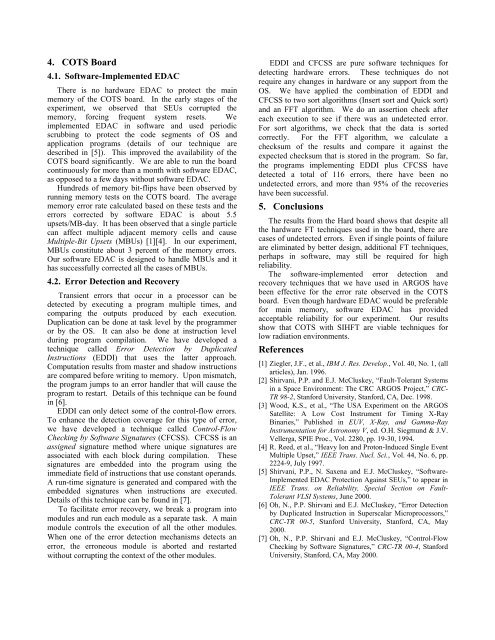Software-Implemented Hardware Fault Tolerance Experiments ...
Software-Implemented Hardware Fault Tolerance Experiments ...
Software-Implemented Hardware Fault Tolerance Experiments ...
You also want an ePaper? Increase the reach of your titles
YUMPU automatically turns print PDFs into web optimized ePapers that Google loves.
4. COTS Board4.1. <strong>Software</strong>-<strong>Implemented</strong> EDACThere is no hardware EDAC to protect the mainmemory of the COTS board. In the early stages of theexperiment, we observed that SEUs corrupted thememory, forcing frequent system resets. Weimplemented EDAC in software and used periodicscrubbing to protect the code segments of OS andapplication programs (details of our technique aredescribed in [5]). This improved the availability of theCOTS board significantly. We are able to run the boardcontinuously for more than a month with software EDAC,as opposed to a few days without software EDAC.Hundreds of memory bit-flips have been observed byrunning memory tests on the COTS board. The averagememory error rate calculated based on these tests and theerrors corrected by software EDAC is about 5.5upsets/MB-day. It has been observed that a single particlecan affect multiple adjacent memory cells and causeMultiple-Bit Upsets (MBUs) [1][4]. In our experiment,MBUs constitute about 3 percent of the memory errors.Our software EDAC is designed to handle MBUs and ithas successfully corrected all the cases of MBUs.4.2. Error Detection and RecoveryTransient errors that occur in a processor can bedetected by executing a program multiple times, andcomparing the outputs produced by each execution.Duplication can be done at task level by the programmeror by the OS. It can also be done at instruction levelduring program compilation. We have developed atechnique called Error Detection by DuplicatedInstructions (EDDI) that uses the latter approach.Computation results from master and shadow instructionsare compared before writing to memory. Upon mismatch,the program jumps to an error handler that will cause theprogram to restart. Details of this technique can be foundin [6].EDDI can only detect some of the control-flow errors.To enhance the detection coverage for this type of error,we have developed a technique called Control-FlowChecking by <strong>Software</strong> Signatures (CFCSS). CFCSS is anassigned signature method where unique signatures areassociated with each block during compilation. Thesesignatures are embedded into the program using theimmediate field of instructions that use constant operands.A run-time signature is generated and compared with theembedded signatures when instructions are executed.Details of this technique can be found in [7].To facilitate error recovery, we break a program intomodules and run each module as a separate task. A mainmodule controls the execution of all the other modules.When one of the error detection mechanisms detects anerror, the erroneous module is aborted and restartedwithout corrupting the context of the other modules.EDDI and CFCSS are pure software techniques fordetecting hardware errors. These techniques do notrequire any changes in hardware or any support from theOS. We have applied the combination of EDDI andCFCSS to two sort algorithms (Insert sort and Quick sort)and an FFT algorithm. We do an assertion check aftereach execution to see if there was an undetected error.For sort algorithms, we check that the data is sortedcorrectly. For the FFT algorithm, we calculate achecksum of the results and compare it against theexpected checksum that is stored in the program. So far,the programs implementing EDDI plus CFCSS havedetected a total of 116 errors, there have been noundetected errors, and more than 95% of the recoverieshave been successful.5. ConclusionsThe results from the Hard board shows that despite allthe hardware FT techniques used in the board, there arecases of undetected errors. Even if single points of failureare eliminated by better design, additional FT techniques,perhaps in software, may still be required for highreliability.The software-implemented error detection andrecovery techniques that we have used in ARGOS havebeen effective for the error rate observed in the COTSboard. Even though hardware EDAC would be preferablefor main memory, software EDAC has providedacceptable reliability for our experiment. Our resultsshow that COTS with SIHFT are viable techniques forlow radiation environments.References[1] Ziegler, J.F., et al., IBM J. Res. Develop., Vol. 40, No. 1, (allarticles), Jan. 1996.[2] Shirvani, P.P. and E.J. McCluskey, “<strong>Fault</strong>-Tolerant Systemsin a Space Environment: The CRC ARGOS Project,” CRC-TR 98-2, Stanford University, Stanford, CA, Dec. 1998.[3] Wood, K.S., et al., “The USA Experiment on the ARGOSSatellite: A Low Cost Instrument for Timing X-RayBinaries,” Published in EUV, X-Ray, and Gamma-RayInstrumentation for Astronomy V, ed. O.H. Siegmund & J.V.Vellerga, SPIE Proc., Vol. 2280, pp. 19-30, 1994.[4] R. Reed, et al., “Heavy Ion and Proton-Induced Single EventMultiple Upset,” IEEE Trans. Nucl. Sci., Vol. 44, No. 6, pp.2224-9, July 1997.[5] Shirvani, P.P., N. Saxena and E.J. McCluskey, “<strong>Software</strong>-<strong>Implemented</strong> EDAC Protection Against SEUs,” to appear inIEEE Trans. on Reliability, Special Section on <strong>Fault</strong>-Tolerant VLSI Systems, June 2000.[6] Oh, N., P.P. Shirvani and E.J. McCluskey, “Error Detectionby Duplicated Instruction in Superscalar Microprocessors,”CRC-TR 00-5, Stanford University, Stanford, CA, May2000.[7] Oh, N., P.P. Shirvani and E.J. McCluskey, “Control-FlowChecking by <strong>Software</strong> Signatures,” CRC-TR 00-4, StanfordUniversity, Stanford, CA, May 2000.


